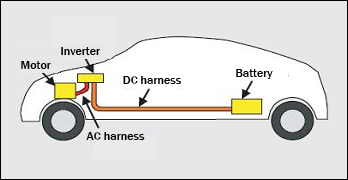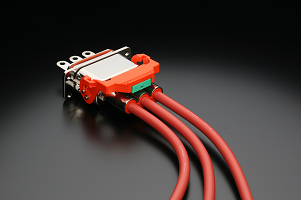2009 The former Hitachi Cable News Release
Information (including product prices, product specifications, details of services, launch dates, inquiry information, and URLs) contained in this news release is current as of the date of the press release but is subject to change without notice. Please note that details may differ from those effective on the search date.
Development of halogen-free, 150-degree-heat-resistant harnesses for use in hybrid electric vehicles
Hitachi Cable, Ltd. has developed halogen-free, 150-degree-heat-resistant harnesses built of a halogen-free material for use in hybrid electric vehicles (HEVs) *1. There is growing demand for reductions in the environmental impact of automobiles; manufacturers are being required to reduce CO2 emissions and enhance fuel efficiency, and governments in many countries are tightening vehicle emissions regulations in order to combat global warming. HEVs, which use a combustion engine and an electric motor in combination, have been garnering attention. As concern for the environment grows, attention is also focusing on the parts used in HEVs. Manufacturers are being required to eliminate environmentally harmful substances, and as a result there is increasing demand for halogen-free HEV harness cables that do not contain chlorine or bromine.
To meet these needs, we have developed a heat-resistant, halogen-free material using proprietary compounding technology. Using this material as cable jacketing, we have developed halogen-free, heat-resistant harnesses for use in HEVs.
HEVs require a DC (direct current) harness to connect the battery to the inverter and an AC (alternating current) harness to connect the inverter to the electric motor. Each of the harnesses consists of a cable and connectors (see Figure 1).
The cables of an HEV harness need to be highly heat-resistant in order to carry a large current in the high-temperature environment near the engine. The cables also need to be flexible, as they are routed through areas with very limited space. The newly developed cable, while coated with a halogen-free material, also has great heat resistance and flexibility and complies with ISO6722 Class D (maximum working temperature: 150°C). In addition, the cable also complies with regulations on hazardous substances, i.e., RoHS *2 and GADSL *3.
The connector has a two-piece configuration, combining a copper alloy and a SUS spring in an aluminum alloy housing that also serves as shielding. Thanks to its structure and housing, the connector is compact while boasting a large current-carrying capacity, significant vibration resistance, and high shielding performance.
We will continue our efforts to develop HEV harnesses that withstand ever more severe working conditions, and to increase sales of our HEV harnesses by communicating to customers their advantages in reducing environmental impact.
| *1 | HEV stands for Hybrid Electric Vehicle. |
| *2 | RoHS (Restriction of the Use of Certain Hazardous Substances in Electrical and Electronic Equipment) is a directive to restrict the use of lead, cadmium, hexavalent chromium, mercury, polybrominated biphenyl (PBB) and polybrominated diphenyl ether (PBDE) in electrical and electronic equipment introduced to the EU market. |
| *3 | GADSL (Global Automotive Declarable Substance List) is a list of substances that are banned or declarable in the automotive field. |
Figure 1. Harnesses installed in HEV
Picture. External view of HEV Harness
Table 1. Properties of the developed harness
| Item | Target | Standard | Performance | |
|---|---|---|---|---|
| Cable | Heat resistance | After exposing the cable to a temperature of 150°C for 3,000 hours, place it in an area at room temperature and wind it using a half turn with an inside diameter of φ65 mm. The cable shall withstand 1 kV for 1 minute and no crack shall appear. | ISO6722 ClassD |
Good |
| Cold resistance | At -40°C, wind the cable using a half turn with an inside diameter of φ65 mm. The cable shall withstand 1 kV for 1 minute and no crack shall appear. | ISO6722 ClassD |
Good | |
| Flame retardance | Subject the cable to a direct flame for 30 seconds. The flames on the cable shall extinguish themselves within 70 seconds. | ISO6722 ClassD |
Good | |
| Flexibility | Bending stiffness shall not exceed 5N (35 mm2 cable) | - | Good | |
| Connector | Current carrying capacity | When an electric current is flowing continuously, the increase in temperature ΔT of the connector shall not exceed 55°C and there shall be no abnormal temperature rise. Also, the tested sample shall have no melt damage | - | Good |
| Vibration resistance | When subjected to random vibrations (2.84 G and 10 to 2,000 Hz), the contact resistance shall be stable, shall not exceed 1 m Ω and there shall be no instantaneous interruption. | ISO16750-3 | Good | |
| Withstand voltage | The connector shall withstand 2.5 kV for 1 minute. | - | Good | |
| Water resistance | A jet of high-pressure water shall be applied to simulate car washing, and water shall not enter the connector. | ISO20653 IP6K9K |
Good | |
| Shielding performance | Connect a cable with connectors to the inverter and to the motor, and measure the noise in each frequency band. The results shall not exceed the CISPR25 standard. | CISPR25 | Good | |

